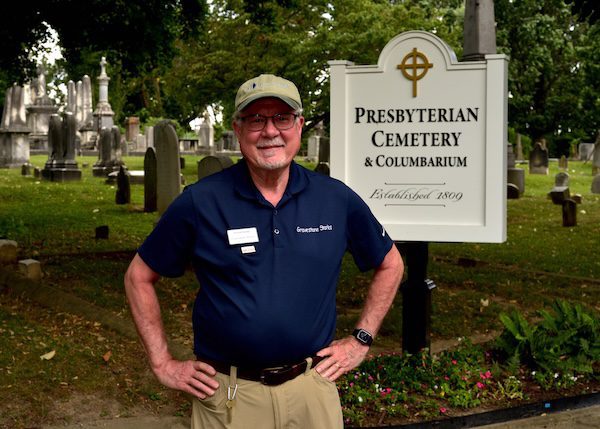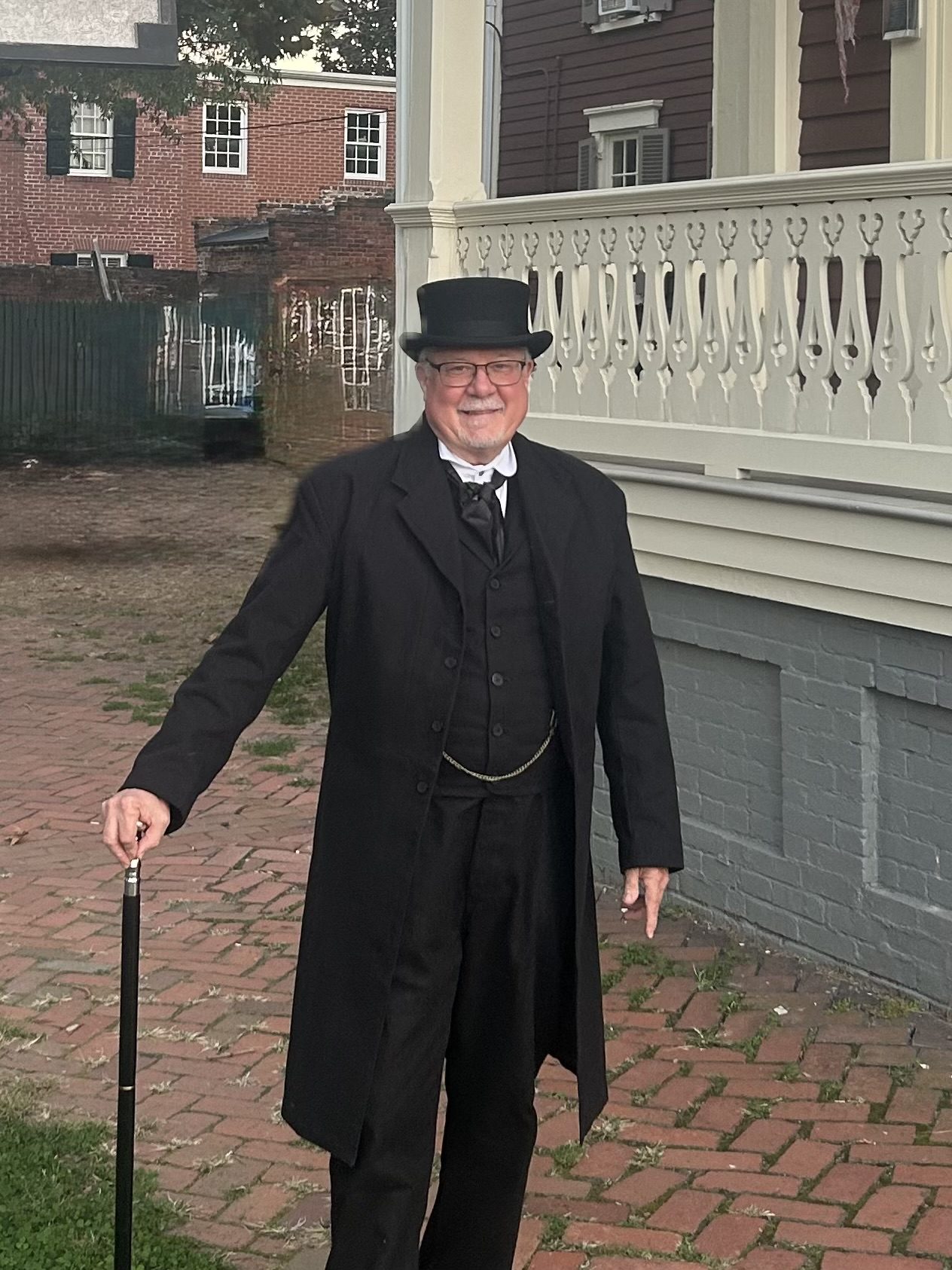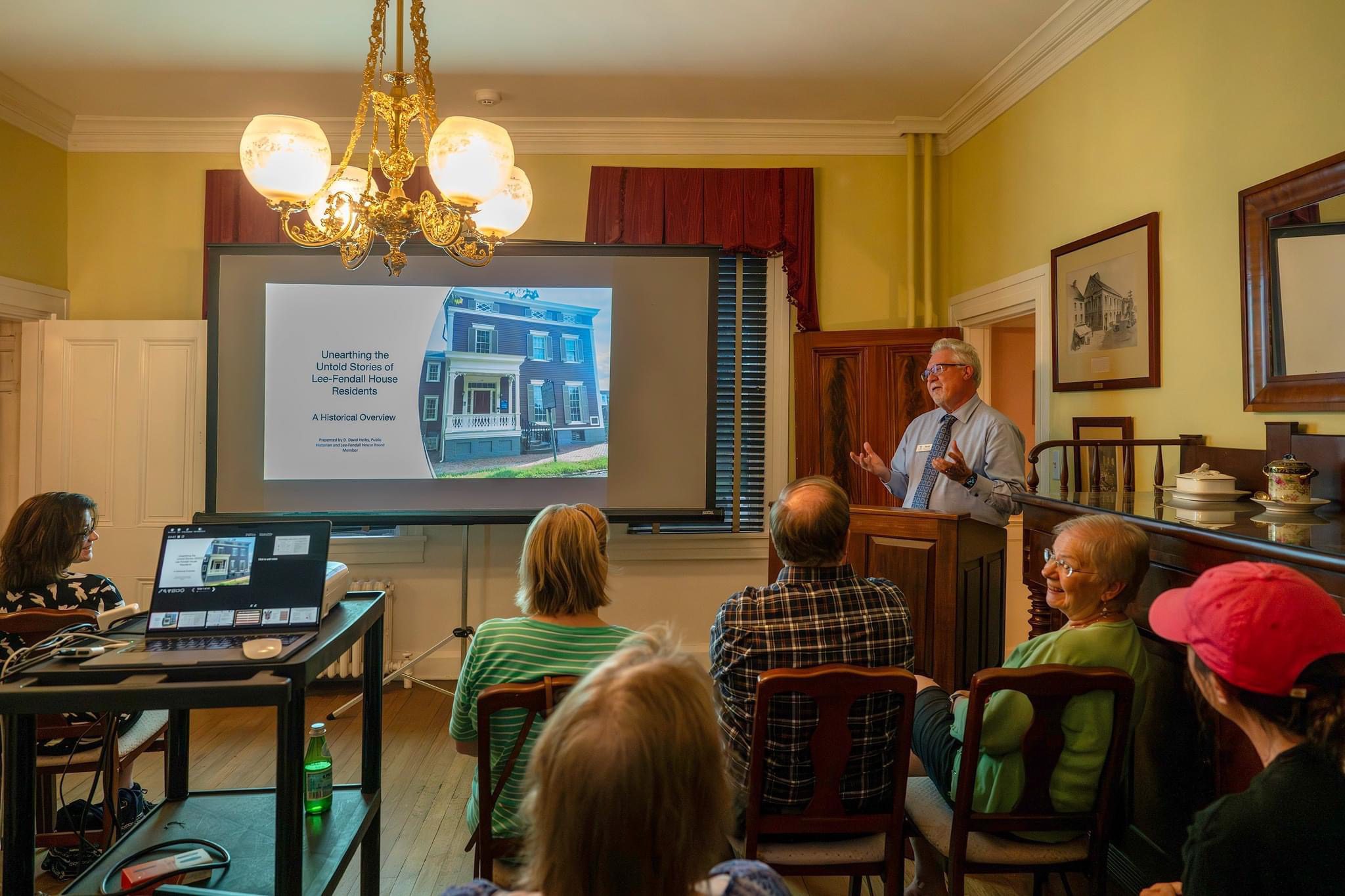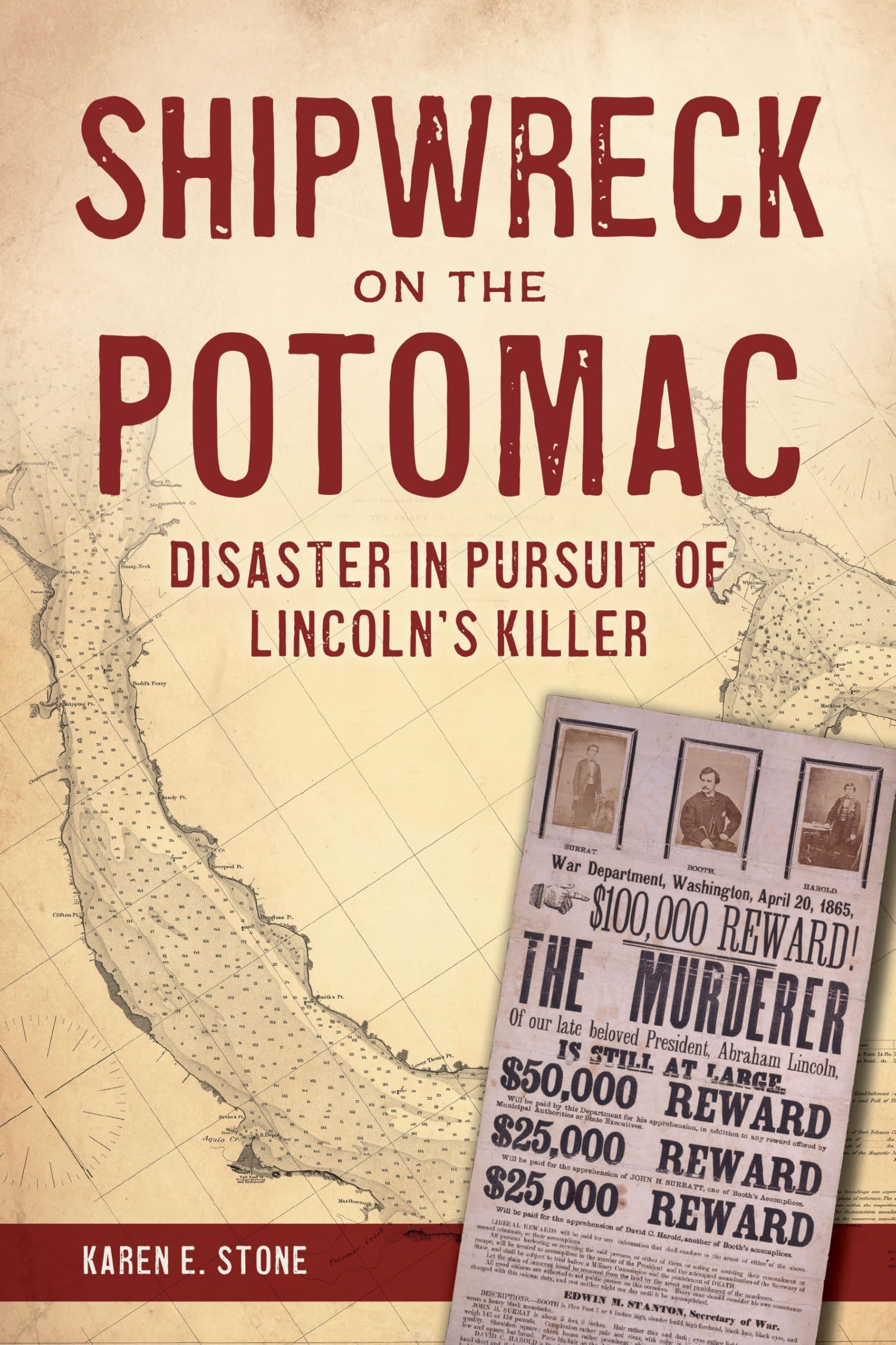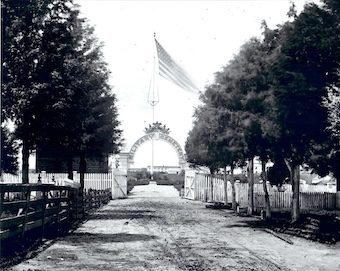Historic Context
Origins of the Methodist Protestant Church
The Methodist Protestant Church originated as a sect within the Methodist Episcopal Church, which was established in 1828. Named in honor of John Wesley, an ordained Anglican cleric and theologian who sparked a revival within the Church of England known as Methodism, this new denomination upheld Wesleyan beliefs. These tenets emphasized the role of salvation and the interplay between grace, faith, and moral purity. While retaining traditional worship practices, the church adopted a congregational form of governance. A prominent figure in this church was Thomas Stockton, who notably served as Chaplain of the United States House of Representatives during various years, including 1833, 1835, 1859, and 1861.
Methodist Churches in Alexandria
In 1829, congregants from Alexandria’s Trinity Church established the Methodist Protestant Church of Alexandria at 110 S. Washington, which was later moved in 1890. For some time, there were three Methodist churches along Washington Street: Trinity (founded in 1774), Methodist Protestant (established in 1829), and Washington Street United Methodist (begun in 1849).
The Methodist Protestant Church suffered a devastating fire in 1952, leading the congregation to decide against rebuilding. Today, the Alexandria Bible Church located on West Braddock Road is considered its spiritual heir.
Founding and Layout of the Cemetery
The Methodist Protestant Cemetery was established officially in 1833. Now out of use, the City of Alexandria maintains the site, which has around 1,500 interments. This cemetery spans the original plots 99, 100, 108, and 109 of Spring Garden Farm, plotted by Fairfax County Surveyor George Gilpin in 1796. The records indicate that the sale of lots and burials commenced in 1836, though the oldest tombstone, belonging to Ann Avery, dates back to June 20, 1830. The cemetery was eventually expanded southward, reaching the border of the Presbyterian Cemetery, although the exact date of this expansion remains undocumented.
A Rare Surviving Receiving Vault
A notable feature of the Methodist Protestant Cemetery is the partially intact receiving vault located in the southwest section of the grounds (GPS: 38.800747, -77.057446). This vault is one of only two known examples remaining in the entire Wilkes Street Cemetery Complex, the other being in Bethel Cemetery. Receiving vaults served an essential function during Alexandria’s colder months, when the ground was too frozen to allow for immediate burial. Caskets were temporarily stored in these structures until the spring thaw permitted proper interment. Architecturally, the vault closely resembles the private Hooff family vault in nearby St. Paul’s Cemetery and the original Washington family vault at Mount Vernon. Though no longer in use, this surviving structure stands as a rare and tangible reminder of 19th-century funerary practices.

Fraternal Symbolism Among the Gravestones
Within the cemetery, many gravestones feature the symbols of various fraternal organizations prevalent in the United States during the 19th century, such as the inscription “I O R M,” signifying the Improved Order of Red Men found on the gravestone of Robert I. Taylor, whose min-bio can be found below.
B
Joseph Bruin (1808 – 1882), Slave Trader and Proprietor of the Infamous Duke Street Slave Jail, Featured in Anti-Slavery Literature
Buried in Alexandria’s Methodist Protestant Cemetery is Joseph Bruin (1808 – 1882), a slave dealer who operated one of the largest slave pens in Alexandria. In 1844, he purchased the brick Federal-style building at 1707 Duke Street and adjacent acreage for his slave jail.
To read the rest of the story, please read Uncovering Alexandria’s Dark History: the Slave Dealer and Jail That Inspired Uncle Tom’s Cabin.

D
Major George Duffey (April 6, 1820 – July 10, 1895) Artisan Legacy: Third Generation Silversmith, Pre- and Post-Civil War Revenue Commissioner
Born on April 6, 1820, Major George Duffey was a third-generation silversmith in Alexandria and lived until July 10, 1895. He lies at rest in The Methodist Protestant Cemetery.
His grandfather, John Duffey, was responsible for crafting the silver trowel used by President George Washington on September 18, 1793, to lay the cornerstone of the United States Capitol building. This same tool was employed in constructing prominent structures like the Smithsonian, United States Supreme Court, National Cathedral, Library of Congress, and Jefferson Memorial.
Today, this treasured artifact can be found at the George Washington Masonic National Memorial.
George Duffey’s father, George Hurd Duffey, who lived between September 11, 1801, and February 2, 1852, owned a tavern on Royal Street. Known as an adept “mechanic,” he worked with materials like steel, brass, silver, and gold in his North Royal Street shop. He is also buried in the Methodist Protestant Cemetery.
| C.S.A. GEORGE DUFFEY Major of Artillery died July 10, 1896. |
Read more at this blog: Major George Duffey: Alexandria’s Silversmith & Confederate Soldier. A Fascinating Historical Journey
E
William Evans (1827 – November 17, 1855) Courageous Volunteer Firefighter: Lost in the Line of Duty at the Dowell China Shop Fire

Originally from England before moving to the United States, Evans was among the Star Fire Company members who lost their lives on November 17, 1855.
They were battling a fire ignited by an arsonist at the Dowell China Shop at 203 King Street.
As the firefighters gained control of the upper levels and some began to extinguish the cellar fire, an unexpected tragedy struck around four in the morning. Just as the firemen were acknowledging their success, the west gable wall of the warehouse collapsed in a horrifying crash, causing floors to burst through. This incident killed seven respected citizens, including Evans, and injured several others. The collapse was due to an explosion of dynamite stored in the warehouse basement.
Catherine Weinraub “The Firefighter’s Memorial in Ivy Hill Cemetery, Alexandria, Virginia.”
The explosion’s shock delayed the bodies’ recovery for several hours. Those killed were Evans, G. David Appich (buried in the Presbyterian), J. Carson Green (buried in Christ Church), John Roach (buried in St. Mary’s), George Plain (buried in Methodist Protestant), Robert Taylor (buried in Methodist Protestant), and James Keene (buried in Methodist Protestant).
Services for the victims were held on November 18th, which were said to have been attended by several thousand people.
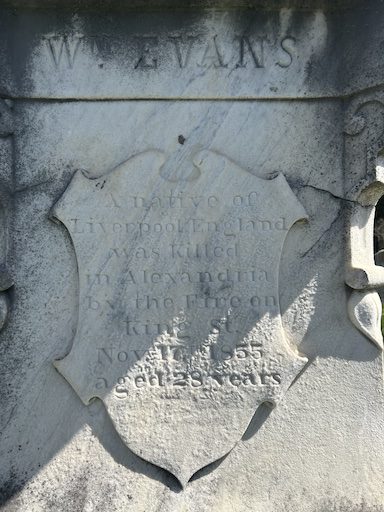
| WM. E. EVANS A native of Liverpool, England was Killed in Alexandria by the Fire on King St. Nov. 17th 1855 aged 28 years Erected to his memory by his brother & sister Thos. & Esabell Evans |
G
Under the Wheels: The Tragic Fate of Charles Glasscock.
Charles Glasscock, a dedicated member of the Friendship Fire Company, met a tragic end on June 30, 1852, two days after he was fatally injured in an accident involving a Fire Engine. Although buried in the plot, the exact location of his gravesite remained unknown, with no gravestone marking it. His burial site remained undiscovered until February 16, 2024, when archaeologist Mark Ludlow, utilizing Ground Penetrating Radar (GPR), made a significant breakthrough while searching for James Keene (see below), another member of the Friendship Fire Company. Keene had lost his life battling the Dowell China Shop fire on November 17, 1855, on King Street.
Ludlow’s GPR scan, conducted in the Methodist Protestant Cemetery circa 1833, revealed intriguing findings within plot areas E60 and E61. No grave markers were present despite James W. Patterson’s purchase of lot E61 on September 7, 1848, as documented in Pippinger’s Tombstone Inscriptions of Alexandria, Virginia Volume 2. However, Ludlow’s examination yielded a solitary burial within plot E60, where Glasscock was believed to rest. This discovery challenged previous assumptions and suggested that Glasscock is the sole occupant of plot E:60.

Interestingly, the plot’s history unfolded further, indicating that it was initially acquired by Enoch Grimes on November 2, 1847, and January 12, 1848, for $100.00. Following Glasscock’s tragic demise, the plot was transferred to the Friendship Firehouse in 1852, underscoring the significance of Glasscock’s service and the community’s acknowledgment of his sacrifice.



H
Samuel Hilton (February 9, 1759 – February 22, 1859): Culinary Artisan and Witness to a Nation’s Founding.
Born on February 9, 1759, Samuel Hilton became renowned for his culinary expertise, particularly in turtle soup, oysters, fish, and wild fowl. He managed Lamb’s Tavern, a significant historical site at the Northwest Corner of Duke and South Union Streets, from November 1796 to November 1799. This establishment wasn’t just a tavern; it was a gathering place for the influential and the ordinary, playing a pivotal role in the community’s social and political life.
Lamb’s Tavern holds a special place in history as the first meeting spot of the old Alexandria-Washington Lodge. On a remarkable day, February 25, 1783, it witnessed the reading of a warrant from the Grand Lodge of Pennsylvania, establishing Lodge No. 39 in Alexandria. Many members were close associates of George Washington and veterans of the Revolutionary War, including Samuel Hilton himself, alongside notable figures like Dr. Elisha C. Dick and George Gilpin.
In 1796, the tavern underwent a transition when John Gadsby announced its renovation into a well-equipped establishment, complete with stables and quality provisions. However, by 1798, possibly due to Hilton’s declining patronage, he leased the tavern. By December 1799, William Buel had taken over, offering boarding services. Tragically, the tavern was destroyed by fire in 1803.
Samuel Hilton was part of a significant historical event on February 22, 1799, when George Washington celebrated his last birthday. The town witnessed a military display, followed by a festive retreat to Hilton’s tavern and other local inns. That evening, a grand ball was held at Gadsby’s Tavern, marking the final birthday celebration Washington attended before his death in December 1799.
Samuel Hilton’s life resonated with historical significance, culminating poignantly as he passed away on February 22, 1852, the same date as George Washington’s birthday. This striking coincidence further binds his legacy with that of America’s first president. Samuel Hilton is interred in Alexandria’s Methodist Protestant Cemetery, where an obelisk stands in his memory. Remarkably, this obelisk also bears the initials of Samuel N. Hilton and James Harrington Hilton, indicating a connection that spans generations. In a unique historical link, Catherine Hilton, Samuel’s wife who passed away on April 24, 1873, along with Samuel N. Hilton and James Harrington Hilton, are laid to rest in Washington’s historic Congressional Cemetery.
Through his stewardship at Lamb’s Tavern, Samuel Hilton forged a culinary legacy and became a silent observer of crucial events in American history; his story is forever linked with the nation’s founding and its foremost hero, George Washington.
| In memory of SAMUEL HILTON born on Feb. 8, 1759 died Feb. 22, 1852 His memory will ever be cherished as a kind husband and father. Rest to thy soul my father In that bright land above: Soon we’ll meet together in realms of heavenly love. S.N.H. Erected by J. H.H |
J
Caroline Matilde Johnson: A Devoted Confederate Supporter with a Family Legacy of Military Service
Caroline Matilde Johnson, born Caroline Matilde Weedon, was a notable supporter of the Confederate cause during the American Civil War. She is best known for smuggling medical supplies and other essential items through Yankee lines to Southern soldiers. Johnson concealed these supplies in numerous pockets sewn into her petticoat, which she wore beneath her large, billowing skirts to avoid detection.
Tragically, just before the Civil War, Caroline’s husband, John Johnson, died from an accident. He was returning home from a meeting when he was attacked and suffered a brain concussion. John was taken to Occoquan, Virginia, just south of the border with Fairfax County, in May 1860. He succumbed to his injuries in December 1860 or early 1861 and was buried in Occoquan.
Their son, John Johnson, Jr. (1860 – 1910), married Mary Agnes Aitcheson, a member of a prominent Alexandria family. At his death, John Jr. was the President of the Alexandria Chamber of Commerce and had a long career with the Robert Portner Brewing Company. He also worked as a bookkeeper for Tacket and Marshall and as a city council clerk. John Johnson, Jr. is buried next to his mother.
On one occasion, Caroline Johnson was tasked with obtaining a plume for the renowned Confederate General Jeb Stuart, who had lost his own in battle. This may have been the hat and plume Stuart lost at Verdiersville on August 17th, 1862, when Federal pickets on reconnaissance struck Raccoon Ford on the Rapidan during a brief lapse in Confederate coverage that evening. Shielded by darkness, they advanced undiscovered into Confederate lines south of the river. Lying on the porch–easy prey for the Yankees–were his cloak, haversack, and, most notably, his new plumed hat. Few scenes of the war so humiliated Stuart: The Yankees made off with the iconic symbol of one of the Confederacy’s most celebrated cavalry commanders.

View source
Stuart got his revenge when he captured General Pope’s headquarters train with all of his official papers, the army treasure chest, and all the General’s and his staff’s personal baggage. (Pope himself was at his headquarters several miles away.) Before sending Pope’s coat to Governor John Letcher in Richmond as a prize of war, Stuart wrote a message to Pope: “General. You have my hat and plume. I have your best coat. I have the honor to propose a cartel for the fair exchange of the prisoners.” John Pope never responded, but J.E.B. Stuart had his revenge for the humiliating loss of his hat and cloak to Pope’s marauders at Verdiersville.
The Southern people widely admired General Stuart for his bravery and charisma. He was mortally wounded at the Battle of Yellow Tavern on May 11, 1864, and passed away at 7:38 p.m. on May 12, 1864. His inconsolable wife, Flora, wore a widow’s black of mourning until she died in 1923. The loss of General Stuart was a significant blow to Confederate morale.
Caroline’s sister, Catherine Ann Johnson, married George O. Plain. Tragically, George died in the November 17, 1855 Dowell China Shop fire in the 200 block of King Street in Alexandria, along with six others. Each October, a moving memorial service is held at Ivy Hill Cemetery’s Fire Fighters Memorial, led by the Alexandria Fire Department, to remember those who lost their lives in the fire.
Although not a direct descendant, Caroline’s family had ties to military service through a sibling of General George Weedon, who served in the Continental Army during the American Revolutionary War.
The Johnson family is buried in plots E:58 and 59.
Acknowledgment: Special thanks to Tracy Burke, a descendant of Caroline Matilde Johnson, for providing valuable oral and written history about the Johnson and Aitcheson families. Her contributions were essential in piecing together the fascinating story of Caroline Matilde Johnson and her family’s legacy in Alexandria, Virginia.
K
James W. Keene (1832 – November 17, 1855) Tragic Fate: English Native Perished in the Dowell China Shop Fire
James W. Keene, a brave fireman who perished while fighting the Dowell China Shop fire on November 17, 1855, serving with the Friendship Fire Company, is thought to have been interred in the Methodist Cemetery.
Recent evidence has raised doubts about our previous assumption that Keene’s grave was in plot E60, the Friendship Fire plot. Further investigation is necessary to determine Keene’s exact burial site within the Methodist Protestant Cemetery.
Nevertheless, Keene’s memory endures each fall during The Alexandria Fire Department’s annual memorial, where he is honored alongside those who have died in the line of duty and other departed department members.
The name of Keene and six others are commemorated on the Firefighters Memorial at Ivy Hill Cemetery in Alexandria, Virginia. The memorial was dedicated in the newly established Ivy Hill Cemetery on the first anniversary of the tragic loss of the seven volunteer firefighters during the Dowell China Shop fire. Ivy Hill Cemetery is situated in the Rosemount area of Alexandria, at 2823 King Street.
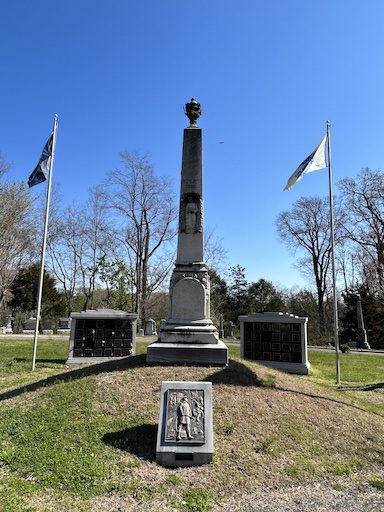
Each October, during Fire Prevention Week, the names of the fallen are read aloud during a service at the monument.
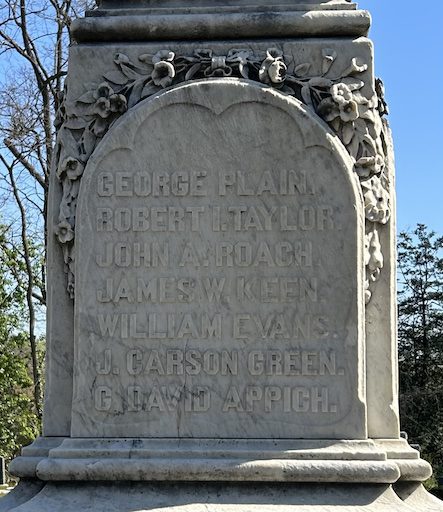
William H. King (1844 – March 28, 1870) Tragic End: Train Engineer Fatally Injured in Railroad Engine Explosion
Train engineer William King, aged 26, was instantly killed when the railroad engine Harrisonburg exploded near Fairfax Station from steam overpressure.

| Our Brother WILLIAM H. KING Was Killed by the explosion of the Engine Harrisonburg March 28, 1870 Aged 26 years. In the midst of Life we are in death. |
Conductor James Franklin Peyton suffered severe wounds, and Martin Murphy, a track worker, was severely scalded. However, both Peyton and Murphy eventually recovered.
Captain Peyton, born on September 24, 1840, and deceased on July 3, 1890, is interred at Washington Street (Union) Cemetery, just a short distance from King Street. Peyton’s unexpected death occurred while employed with Virginia Midland Railroad, previously known as O&A Railroad, before merging with Lynchburg and Danville Railroad in 1872. Peyton’s obituary provides further details, but the subsequent events of Murphy’s life remain unknown.

The Orange and Alexandria Railroad was known as “the most fought-over railroad in the American Civil War.” Throughout the conflict, control of this strategically important rail line was heavily contested by Union and Confederate forces. Running from Alexandria to Gordonsville and connecting with other key railroads, the Orange and Alexandria was a vital supply and transportation link for both sides. Its tracks witnessed numerous battles and skirmishes as armies sought to control this critical asset. Fairfax Station functioned as the evacuation site for Union soldiers injured in the battles of Chantilly and Second Manassas. It remained the last active railroad depot in Fairfax County until 1973, and the site is now home to the Fairfax Railroad Museum.
P
George O. Plain (1809 – November 17, 1855) Fallen Hero: Volunteer Firefighter Fatally Lost in Dowell China Shop Fire
On November 17, 1855, during the late hours of the night, Plain was one of the seven individuals who tragically perished while bravely battling a fire alongside the Star Fire Company. The fire broke out at the Dowell China Shop, which once stood at 203 King Street but has since been lost to history. During the incident, Mr. George Plain was positioned in the upper section of the building, gripping a hose pipe at the time of the accident.

Plain was a skilled painter by profession. When he passed away, he left behind a widow named Cartharine A. Johnston, along with their six children: Benjamin, aged 18; Ann (also known as Anna Bella), aged 15, Mildred aged 12, John aged 10, Catharine aged 8, and the youngest, Caroline Amy, aged 5.
On November 19th, he was laid to rest alongside William E. Evans, James W. Keene, and Robert I. Taylor, interred in the Methodist cemetery. The funerals were attended by an estimated crowd of over 4,000 people.
| Sacred to the memory of GEORGE O. PLAIN who was killed at the fire on King St. Nov. 17th, 1855, in the 37th year of his age leaving disconsolate widow and six children to mourn his loss. None knew him but to love him, none named him but in praise My head and stay is called away and I am left alone My husband dear to me so near, is called away and gone. It grieves my heart tis hard to part with one who was so kind Where shall I go to tell my woe and ease my troubled mind. |
S
John Slater (1811 – February 11, 1883). An award-winning Horticulturist.
John Slater, born in 1811 in Oundle, East Northamptonshire Borough, Northamptonshire, England, made the life-changing decision to immigrate to the United States. In 1840, he acquired Bellevue Plantation, a historical estate likely constructed in the late 1780s. Slater was an accomplished horticulturist and collaborated with William Yeates of Yeates Garden, situated on Franklin Street in Alexandria.
At Bellevue, Slater introduced a delightful array of roses, dahlias, and strawberries. He cultivated a diverse garden with rhubarb, asparagus, lettuce, peas, and tomatoes. Additionally, he nurtured Barlett Pears and Catawba grapevines, showcasing his passion for horticulture.
During the tumultuous years of the Civil War, Slater demonstrated his generosity by donating strawberries to the Mansion House Hospital, which stood in front of the Carlyle House on N. Fairfax Street. Beyond his horticultural pursuits, he also served as an election officer and held the position of Trustee of Public Schools.
Tragically, Slater passed away at seventy-two on February 1, 1883. Bellevue remained within the Slater family for several generations, but its fate took a turn in 1912 when a powerful storm ravaged it. Today, the location of Bellevue is marked by Marina Towers.
Today’s modern Slater’s Lane traces the course of an earlier historic road, which once served as the primary route to access Bellevue Plantation and possibly the Dade Plantation. This road earned its name in honor of the influential Slater family, marking their enduring legacy in the area.
| JOHN SLATER a native of Oundle, England born 1811 died Feb. 1st 1883 J. SLATER |
T
Robert I. Taylor (1814 – November 17, 1855) Guardian and Hero: I.O.R.M. Member and Firefighter Lost in the Dowell China Shop Fire
Taylor belonged to the Improved Order of Red Men, an organization with roots in the Sons of Liberty, who were involved in the American Revolutionary War. Symbols of this organization are etched into his gravestone.
On the night of November 17, 1855, Taylor was among the seven men who lost their lives while fighting a fire with the Star Fire Company at the Dowell China Shop located at 203 King Street (a building that no longer exists).
His name can be found on the Fire Fighters Obelisk at the entrance of Ivy Hill Cemetery on King Street, alongside James Keene and William Evans, George O. Plain, G. David Appich, J. Carson Green, and John Roach.
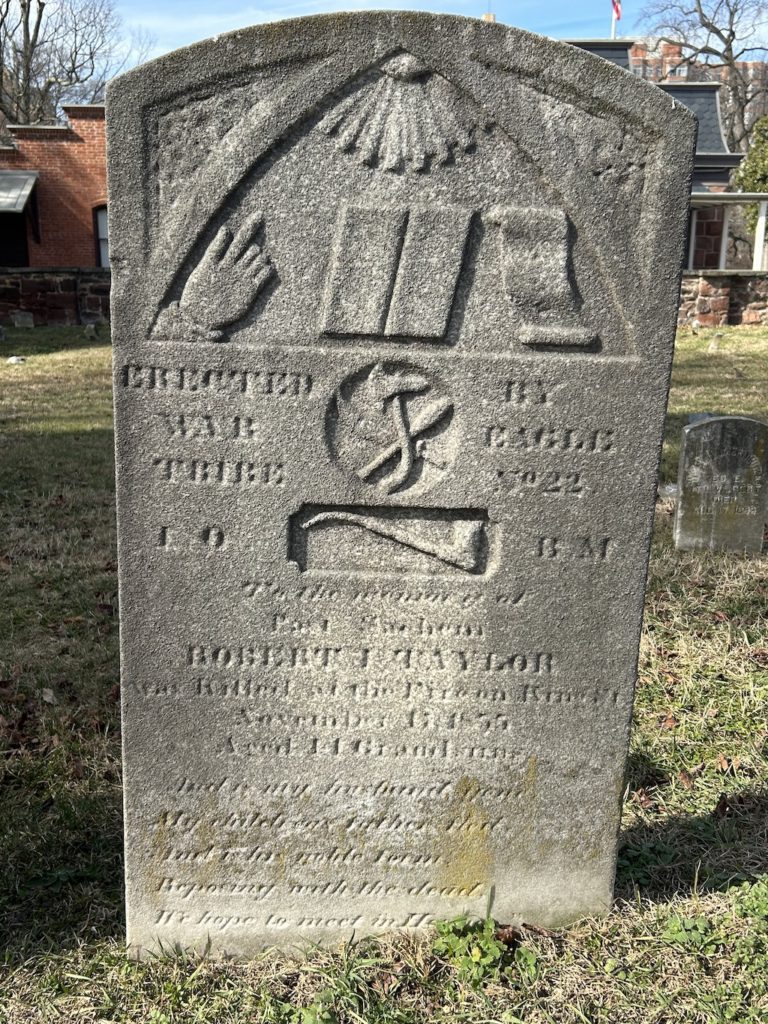
| Erected by War Eagle Tribe no. 22 I.O.R.M. To the memory of Past Sarhem ROBERT I. TAYLOR was killed at the Fire on King St. November 17, 1855 Aged 41 Grand yrs. And is my husband gone My Children’s father fled And in his noble form Reposing with the dead We hope to meet in Heaven |
Y
Joseph H. Young (1828–1893 – Alexandria’s first paid Fire Department Employee
Joseph H. Young, a native of Philadelphia, made lasting contributions to Alexandria’s firefighting history. During the Civil War, he served with distinction in the 11th New York Volunteer Infantry—better known as the Zouaves—where he operated one of two horse-drawn steam fire engines brought to Union-occupied Alexandria. These engines, placed near Fairfax and Princess Streets, were the first steam-powered firefighting equipment seen in the city and represented a dramatic shift from hand-drawn, manually operated engines to more efficient steam-driven technology.

After the war, the city purchased one of the engines, and Young—recognized for his mechanical expertise—was retained as its engineer. He became a member of the Hydraulion Fire Company, founded in 1827 in response to the city’s great fire. In 1866, Young was appointed as Alexandria’s first paid fire department driver, living on Royal Street, near the engine house.
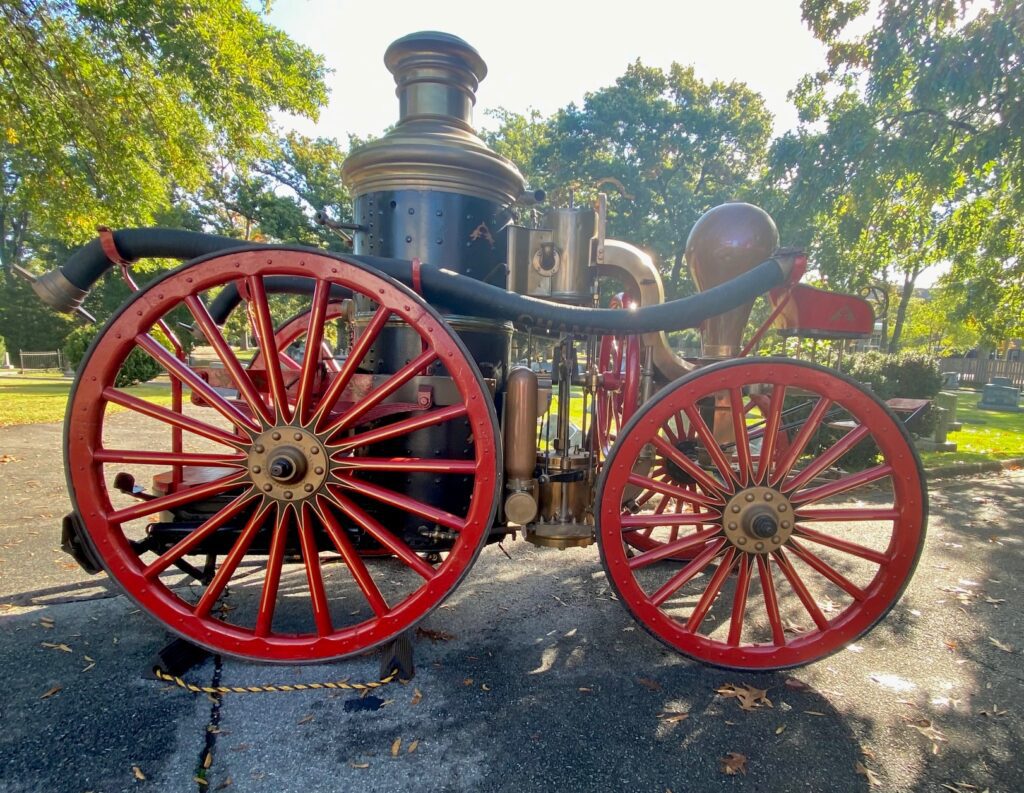
Despite his pioneering role, Young’s career was marked by both professional dedication and personal struggles. He was removed from duty in 1880 due to charges of drunkenness and vertigo, but later worked as a guard and was reinstated in 1884. In 1885, despite accusations of intemperance, he demonstrated bravery by preventing a potentially catastrophic fire at Sarepta Hall, where he extinguished burning matchboxes scattered near a staircase during a Salvation Army meeting. He was formally commended for his faithful and efficient service in 1887 and 1889.

However, in May 1889, during a fire response, Mayor Downham found Young under the influence while operating the engine. The Alexandria Gazette reported that Young had “freely indulged in liquor on the occasion of yesterday’s celebration,” leading to his dismissal the following month.
Joseph H. Young died of pneumonia on March 9, 1893, at age 64. His funeral was a moving testament to his impact on the fire service. Members of three fire companies participated, with two from each serving as pallbearers. In a fitting tribute, the Hydraulion hose reel was transformed into a hearse and pulled by his comrades through the streets of Alexandria. He was laid to rest in the Methodist Protestant Cemetery, part of the Wilkes Street Cemetery Complex—a final resting place befitting one of the city’s earliest professional firefighters.

| In Memory of JOSEPH H. YOUNG Born July 9, 1823 Died March 9, 1893 |
Sources of Information
Stowe, H. B. (1854). The Key to Uncle Tom’s Cabin. Jewett Publishing.
Wedderburn, A. J. (1907). Souvenir Virginia Tercentennial of Historic Alexandria, Va., Past and Present. [Alexandria]. Retrieved from the Library of Congress website: https://www.loc.gov/item/11031827/
Wallace, L. A., Jr. (1990). 17th Virginia Infantry. H.E. Howard, Inc.
Greenly, M. (1996). Those Upon the Curtain Has Fallen: The Past and Present Cemeteries of Alexandria, VA. Alexandria Archaeology Publications.
Powell, M. G. (2000). The History of Old Alexandria, VA, from July 13, 1749 – May 24, 1861 (W. E. Pippenger, Index). Willow Bend Books.
Pippenger, W. E. (2008). Tombstone Inscriptions of Alexandria, Virginia: Volume 2. Heritage Book, Inc.
Hakenson, D. C. (2011). This Forgotten Land Volume II, Biographical Sketches of Confederate Veterans Buried in Alexandria, Virginia. Self-published.
Weinraub, C. (2017). The Firefighter’s Memorial in Ivy Hill Cemetery, Alexandria, Virginia. The Alexandria Chronicle, Fall 2017. Alexandria Historical Society, Inc.
